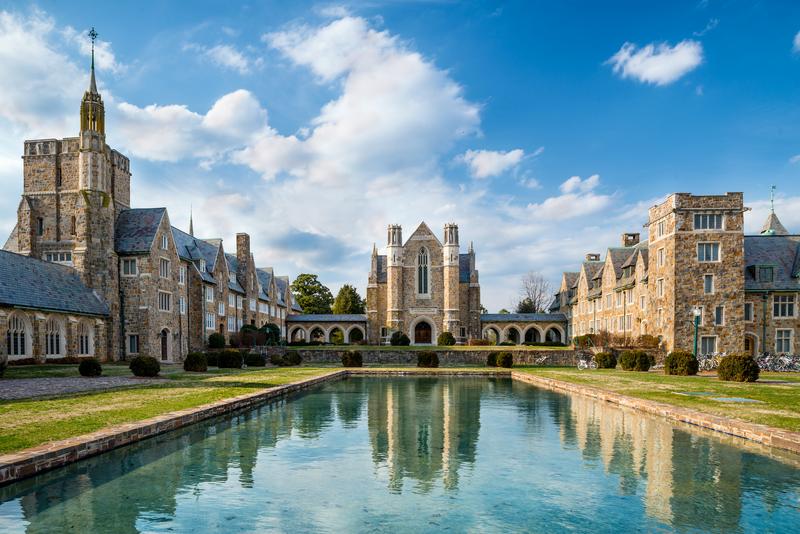As students start researching different colleges to apply to, most start their research by looking at ranks and majors. However, one aspect that is overlooked is the architecture within a college campus.
Being able to go to a college that you see as visually pleasing can impact how you react to your new learning environment. While you can find beauty in every single college, some stand out to most. The amazing and rich history behind the architecture makes them some of the
most beautiful campuses in the country.
Four Colleges with Great Campus Architecture
Berry College is a private liberal arts institution in Rome, Georgia. This campus is one of the largest campuses as it extends to about 27,000 acres. It consists of a Gothic Revival style, which gives the school a sense of timelessness and grandeur.
Some of the most famous buildings are the Ford buildings, which showcase Gothic architecture with their pointed arches, stone facades, and intricate detailing. The Memorial Library at Berry College features a striking tower, pointed arch windows, and a sense of symmetry while serving as a central hub for learning.
This place reflects the founder, Martha Berry’s, vision as a place where education, work, and Christian values were integrated, which is seen in the architecture. Beyond the buildings, the campus is against the backdrop of Lavender Mountain, making it perfect for nature lovers.
Flagler College is a
private liberal arts college in St. Augustine, Florida. Flagler College's architectural allure is epitomized by the former Hotel Ponce de Leon, a masterpiece of Spanish Renaissance design.
Completed in 1888, and designed by architects John Carrère and Thomas Hastings, the building stands as a visual marvel with its ornate carvings, arches, and red-tiled roofs. The Hotel Ponce de Leon, now a centerpiece of the campus, boasts a castle-like appearance with towers and turrets that offer panoramic views of St. Augustine's historic district.
The meticulously preserved courtyards and gardens add a touch of tranquility to the surroundings, creating spaces for students to study and unwind. Recognized as a National Historic Landmark, the college's commitment to the preservation and restoration of its historic buildings ensures the continuity of the original design's beauty.
This integration of the old with modern facilities creates a distinctive and dynamic learning environment, where students are inspired by the architectural grandeur that envelops them,
fostering a sense of tradition and excellence in education.
The University of San Diego is a private Roman Catholic research university in San Diego, California. The University of San Diego boasts an architecturally captivating campus that blends Spanish Renaissance aesthetics with modern facilities. The campus is marked by red-tiled roofs, arched walkways, and meticulously landscaped courtyards, all paying homage to its Southern California location and Spanish heritage.
The centerpiece is the Immaculata Church, a stunning structure that stands as a symbol of the university's commitment to faith and community. Noteworthy is the Founders Hall, an iconic building that harmonizes traditional and contemporary design elements.
The Joan B. Kroc Institute for Peace and Justice, with its striking modern architecture, reflects USD's dedication to social justice. The campus's strategic layout offers panoramic views of Mission Bay, the Pacific Ocean, and the city of San Diego, adding to the overall allure.
With a
commitment to sustainability, the University of San Diego's campus serves as a visually inspiring backdrop for academic pursuits, seamlessly integrating history, spirituality, and innovation.
Princeton University, located in Princeton, New Jersey, boasts a rich architectural heritage that reflects its long-standing history and commitment to academic excellence. The campus features a diverse array of architectural styles, with a significant influence from Collegiate Gothic and Richardsonian Romanesque designs.
Iconic structures such as Nassau Hall, the university's oldest building, showcase these styles, contributing to the overall aesthetic appeal of the campus. Additionally, modern and innovative architectural elements have been seamlessly integrated into the campus, exemplified by buildings like the Lewis Science Library and the Frank Gehry-designed Lewis Center for the Arts.
The thoughtful combination of tradition and innovation in Princeton's architecture mirrors the institution's dedication to blending a deep appreciation for its historic roots with a forward-looking approach to education and research. The campus layout, characterized by picturesque courtyards, lush green spaces, and iconic landmarks, further enhances the overall beauty and functionality of the Princeton University environment.
When
students are visiting schools such as those listed above they should ask about the historic meaning behind certain buildings. This can give you insight into the history of the school and the principles on which the school was founded.
Taking campus tours is so important as it will give you the chance to see if you can see yourself attending a certain school. In the maze of college decisions, one element still often underestimated is the impact of a campus's appearance.
It's more than just about pretty buildings; it's about the feel of the place and how it shapes your college journey. Imagine walking through ivy-covered halls or sleek, modern structures – it's not just about aesthetics, it's about how that environment influences your day-to-day life. The vibe of a campus can affect your mood, creativity, and connection to the school's story.
Choosing a college is a complex decision involving academics, faculty, and more, but the look and feel of a campus shouldn't be overlooked. It's like the first chapter of your college story, setting the tone for your adventure.
So, while it's not the only factor, the way a campus looks can add that extra touch of magic to
your college experience. After all, who wouldn't want their college years to unfold in a place that feels like home?
